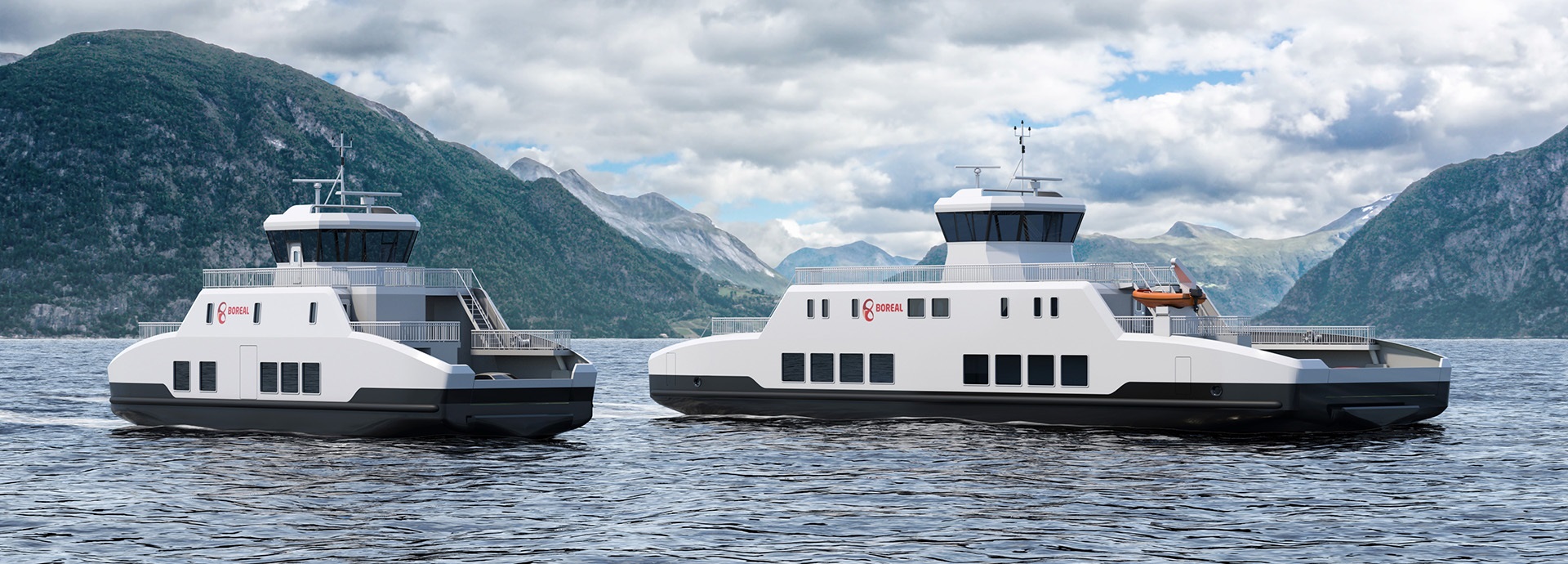

When Norwegian ferry operator Boreal Sjö tendered for two ferry routes in the south of the country, it wanted to design two all-electric ferries. The battery-powered solution provided by Wärtsilä enables zero-emission transportation in a popular tourist destination, lower costs compared to diesel and better vessel manoeuvrability and efficiency.
Boreal Sjö is one of the largest ferry operators in Norway, with routes throughout the country. When the company won the tender for the Launes to Kvellandstrand and Abelnes to Andabeløy routes, they specified Wärtsilä as the system designer and technology provider for two new double-ended shuttle ferries. The routes connect the mainland with neighbouring islands and are an essential part of the country’s transport system for both local residents and tourists.
One of the ferries is a 30-metre vessel capable of carrying 10 cars and approximately 100 passengers, the other a 50-metre vessel with space for 35 cars and 149 passengers. Both vessels operate short, fixed-destination routes that are ideal for all-electric operation, with a one-way trip only taking around ten minutes, meaning battery capacity is not an issue.
A comprehensive, integrated equipment package
The system Wärtsilä designed has been meticulously tailored to the vessels’ operating and route profiles. In addition to designing the system, Wärtsilä also supplied the thrusters, batteries, onboard and onshore battery charging equipment, back-up generators and various electrical systems. The scope also included the control system, an integrated alarm system and the power management system.
All these components need to work seamlessly together if the vessels are to take full advantage of the benefits of fully electric operation, and this is where Wärtsilä’s systems integration expertise really comes into its own.
The vessels use the local onshore power grid for charging via a dedicated charging tower located on the quayside, which enables automated quick charging between voyages. At night the vessels use a normal 400-volt plug-in solution for slower charging.
“The vessels are based on existing, proven components, meaning the biggest part of the project was the integration work,” says Sigmund Lidal, Senior Project Manager at Wärtsilä. “This was quite a demanding project – you have the onshore grid and charging system, the charging system on the vessel and the onboard battery. Ensuring the safety and efficiency of all of these elements was a much more complex task than with a diesel-electric setup,” he explains.
Balancing everything and controlling the batteries’ charging and discharging cycles is the Wärtsilä energy management system (EMS). With charging taking place on the mainland quay after each 20-minute round trip, a low charge shouldn’t be a challenge during normal operation, but if it is the EMS will use one of the two onboard gensets to supply additional power.
Having all the equipment contracted from Wärtsilä also means there is single point of contact for maintenance, spare parts and support, which is far less stressful and time-consuming for Boreal Sjö than dealing with multiple service providers. Wärtsilä is also responsible for supporting both the vessel and the quayside charging tower.
Benefits all round
In addition to helping Boreal Sjö win its tender, the Wärtsilä system has a range of ongoing benefits for the operator. Starting onboard, the fully electric drive train offers a very fast response time. This greatly increases manoeuvrability and efficiency, which is a benefit for any vessel, but even more so for vessels that have to dock after every ten minutes of sailing. In addition, the ferries are less costly to operate as the electric power they use is cheaper than diesel fuel. Last but by no means least are the environmental benefits: zero emissions and much quieter operation compared to a diesel powertrain.
Fully electric ferries like this are set to become more and more common in the near future. “There is demand to electrify the whole fleet in Norway,” says Harald Tillung, Senior Expert, Initial Design at Wärtsilä. “Journeys of up to 50 minutes are simpler to electrify as battery capacity is not an issue, and this process has already started. In addition to this, ferry operators in many other countries – including Canada, the US and Australia – have expressed interest in electrifying their fleets to achieve zero emissions,” explains Tillung.
As an organisation we take a zero-harm approach to the environment, and our fully electric vessels have a critical role in this regard as we seek to minimise the emissions from our operations. Wärtsilä’s holistic approach to system design and integration means we are able to take full advantage of the benefits of fully electric operation and, with one point of contact for maintenance, spare parts and support, we can be confident that the vessels will operate reliably and safely over the long term.
Related solutions
Did you like this? Subscribe to Insights updates!
Once every six weeks, you will get the top picks – the latest and the greatest pieces – from this Insights channel by email.



